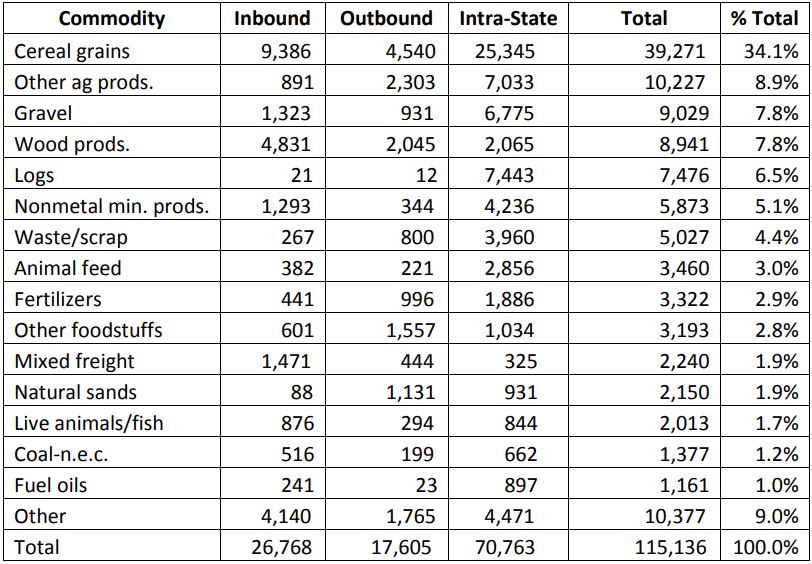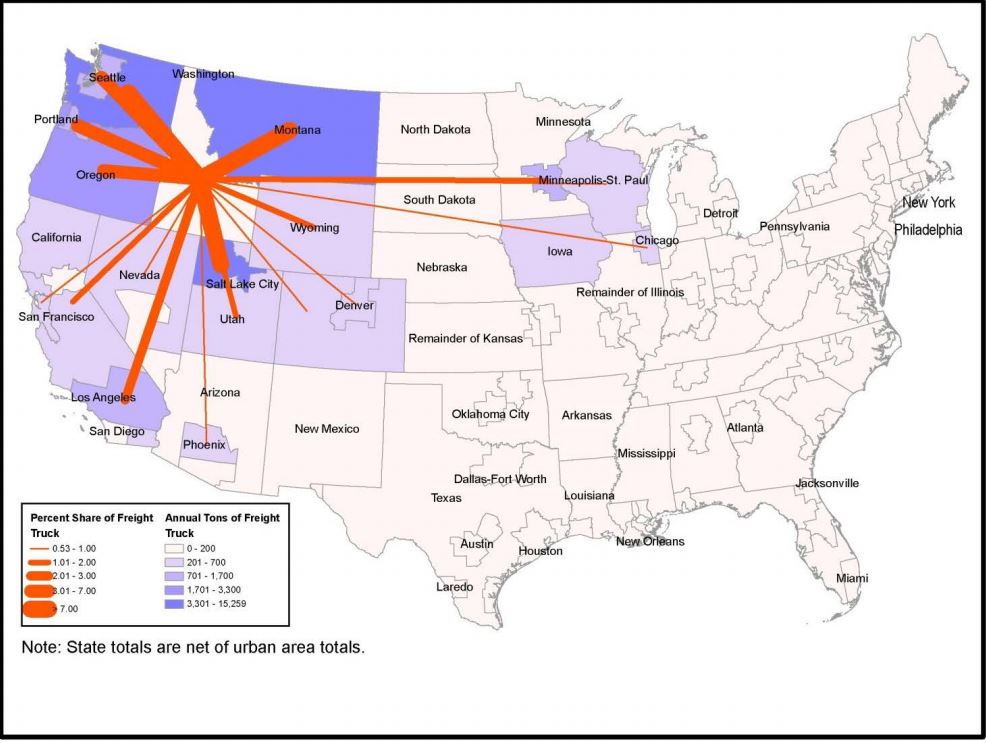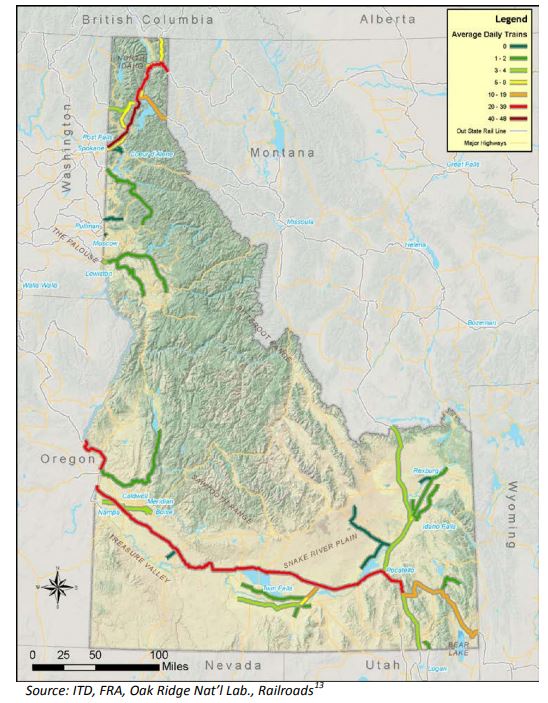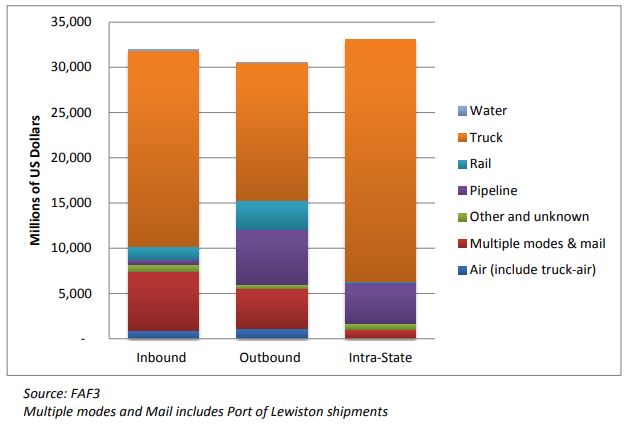
State Freight: Idaho
Freight in the State of Idaho
By Seth Newman
State: Idaho
Nickname: The Gem State
Population: 1,754,208 (2018)
Capital: Boise
Large Freight Volume Cities: Boise, Nampa, Idaho Falls, Pocatello, Meridian, Twin Falls, Caldwell, Lewiston and Rexburg.
According to the Idaho Department of Transportation, the number one group of commodities moved by trucks is agriculture products which include cereal grains and other animal feed. Together, they make up about 42 percent of all commodities moved by trucks for the state. The overwhelming majority of these are moved within the state, even though there are also significant inbound and outbound movements. In addition to agriculture products, building materials including gravel, wood products, and logs also generate significant truck traffic. Gravel and logs are primarily moved within the state, while wood products are mostly moved into the state widely-distributed wood product processing and manufacturing plants. The following chart provides a look at the inbound/outbound shipments for Idaho per year, provided by the Idaho Department of Transportation.

As mentioned above, there are some significant truck trade flows between Idaho and other large metropolitan areas including Los Angeles and Minneapolis, but truck flows are predominantly limited to a 1-day truck trip distance from Idaho. Freight flowing in and out of Idaho are typically going to its neighbor states.

Idaho’s biggest source of of truck traffic volume occurs on the interstates, especially near Boise City, where more than 5,000 trucks per day traverse through those sections of highway. Some state highways also experience significant truck volume of more than 1,000 trucks a day.
Freight corridors from a national perspective show high volumes of trucks, in the case of Idaho, the only major freight corridor identified is I-84 that connects Salt Lake City, Utah to Portland, Oregon.

Idaho is prime for intermodal transportation, with total freight tonnage in Idaho anticipated to increase by nearly 72% by 2040, cost effectiveness and efficiency of transport will become important considerations in modal choice and modal investment in the future. Freight rail is a good transportation option, particularly for low value, bulk product transport, because of its efficiency. From a fuel efficiency standpoint, rail can transport one ton of freight 469 miles per gallon of fuel, and is four times more fuel efficient than a truck, on average. One train can haul the freight of several hundred trucks, which means less highway gridlocks and reduced impact on highway maintenance and capacity expansion investments.
Rail is a critical component of Idaho’s freight system for hauling bulk commodities, including agricultural products, basic chemicals (serving the food processing, wood, and chemical industries), fertilizers, cereal grains, and other agricultural products. The rail system in Idaho consists of a network of railroads, rail hubs and yards, and truck to rail transfer facilities

Located at the confluence of the Snake and Clearwater Rivers, the Port of Lewistown is located 465 miles upriver from the Pacific Ocean. It is the most inland sea port on the west coast, and Idaho’s only water port. The Port of Lewiston provides essential intermodal transportation options, particularly for the transportation-challenged agribusinesses located in central Idaho. Barge transport is an excellent means of freight transport, particularly for low-value, bulk commodities such as timber, grain, and other agricultural products, because of its cost effectiveness, and for oversized cargo, because of the logistical challenges. From a fuel efficiency standpoint, a ton of commodity can be moved 514 miles on one gallon of fuel on a loaded barge, nearly five times as fuel efficient as truck transport.
The Port hosts a 150,000 square foot distribution center with 10 truck bays and 5 rail bays, and offers indoor and outdoor warehousing and storage for forest and paper products, manufactured goods, and other agricultural products. It operates a container yard and offers facilities for loading and unloading both general and containerized (20’ and 40’ containers) cargo from barges.

Grain is the Port’s chief commodity, and the Port is partnered with two grain facilities, Lewis Clark Terminal and CLD Pacific Grain, LLC, with a combined grain storage capability of 6.2 million bushels. Between 7,000 and 10,000 containers of exports are shipped from the Port of Lewiston to the Port of Portland by barge each year. According to Port of Lewiston shipping records, in 2010, bulk wheat shipments from Idaho’s only water port totaled 585,373 tons.
In conclusion, Idaho has a large volume of freight with agricultural products like grain, wood and potatoes but most destinations for the freight are within a day’s transit time to neighboring states. The best opportunity for freight would be in Boise, Idaho as it’s part of the freight corridor that connects Salt Lake City, Utah and Portland, Oregon. Intermodal is a strong option for freight transportation in Idaho when hauling bulk commodities. The Port of Lewiston is the most inland sea port on the West Coast, but it’s home to a high volume of barge freight that needs to be transported to central Idaho.
This report used facts, numbers, records and charts found in the Idaho Statewide Freight Study prepared for by the Idaho Transportation Department.